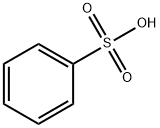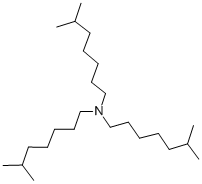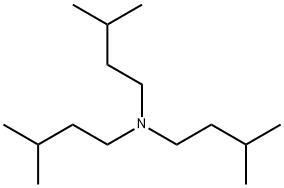Triisobutylaluminum
Synonym(s):Aluminumtriisobutanide;TIBA;TIBA solution
- CAS NO.:100-99-2
- Empirical Formula: C12H27Al
- Molecular Weight: 198.32
- MDL number: MFCD00008929
- EINECS: 202-906-3
- SAFETY DATA SHEET (SDS)
- Update Date: 2025-01-27 09:38:02

What is Triisobutylaluminum?
Chemical properties
clear colorless to light yellow solution
Chemical properties
The aluminum alkyls are highly flammable and reactive, colorless to yellow liquids at room temperature. The lighter trialkylaluminums ignite spontaneously in air. They are normally supplied and used in a 20% solution with a hydrocarbon solvent, such as hexane, heptane, benzene, toluene. Properties may depend on solvent. Reacts violently with water.
The Uses of Triisobutylaluminum
Triisobutylaluminium is a useful reagent for preparing anti-corrosive coating materials.
The Uses of Triisobutylaluminum
Polyolefin catalyst, manufacture of primary alcohols and olefins, pyrophoric fuel.
The Uses of Triisobutylaluminum
Triisobutylaluminum is used as a reducingagent. It is also used in combinationwith transition metal compounds as aZiegler-Natta catalyst in polymerization andhydrogenation reactions. A dilute solution ofthe compound is employed in commercialapplications.
Definition
A mixture of isomers readily prepared by polymerizing isobutylene. A typical mixture is 2,2,4,6,6-pentamethylheptane- 3 and 2-neopentyl-4,4-dimethylpentene-1. May be depolymerized to simpler isobutylene derivatives.
Air & Water Reactions
Pyrophoric. Reacts violently with water producing flammable gas [Rose 1961].
Reactivity Profile
Triisobutylaluminium reacts violently with alcohols, phenols, amines, carbon dioxide, sulfur oxides, nitrogen oxides, halogens, and halogenated hydrocarbons, causing fire and explosion hazards [Handling Chemicals Safely 1980. p. 937].
Health Hazard
Inhalation of smoke from fire causes metal-fume fever (flu-like symptoms). Contact with liquid can cause severe burns of eyes and skin because of spontaneous ignition.
Health Hazard
Being moisture sensitive, the pure liquid orits concentration solution can cause serverburns to the skin.
Fire Hazard
It is a highly pyrophoric compound, igniting spontaneously in air. The flash point is measured to be -18°C ( -1°F) (Aldrich 1996). A 1.0 M solution in hexane or toluene is pyrophoric too. It decomposes explosively with water. Reactions with lower alcohols, halogenated hydrocarbons, halogens, and common oxidizing substances can be violent or explosive. Triisobutylaluminum is thermally less stable than triethylaluminum, decomposing above 50°C (122°F), producing isobutene and hydrogen.
Safety Profile
A poison. Extremely destructive to living tissue. A very dangerous fire hazard; ignites on exposure to air. Incompatible with moisture, acids, air, alcohols, amines, halogens. To fight fire, use CO2, dry sand, dry chemical. Do not use water, foam, or halogenated extinguishing agents. When heated to decomposition it emits acrid smoke and irritating fumes.
Potential Exposure
Alkyl aluminum compounds are used as components of olefin polymerization catalysts. They are also used in the synthesis of higher primary alcohols and in pyrophoric fuels, as a catalyst in making ethylene gas; and in plating aluminum.
Shipping
ntial fire or explosion hazard. Shipping: UN3399 Organometallic substance, liquid, water-reactive, flammable, Hazard Class: 4.3; Labels: 4.3 Dangerous Dangerous when wet material, 3-Flammable liquid, technical name Required. UN3051-Spontaneously combustible. Also, this material is dangerous when wet. (Note: this number does not appear in the 49/CFR HazMat tables).
Incompatibilities
The lighter trialkylaluminums ignite spontaneously in air; can self-heat in the air at room temperature without any added energy and may ignite. These compounds are strong reducing agents. Incompatible with oxidizers (chlorates, nitrates, peroxides, permanganates, perchlorates, chlorine, bromine, fluorine, etc.); contact may cause fires or explosions. Keep away from alkaline materials, strong bases, strong acids, oxoacids, epoxides. Incompatible with water, oxygen (air), acids, alcohols, phenols, amines, carbon dioxide; sulfur oxides; halogenated compounds, and many other substances
Waste Disposal
Careful incineration
Properties of Triisobutylaluminum
| Melting point: | 4-6°C |
| Boiling point: | 68-69 °C |
| Density | 0.848 g/mL at 25 °C |
| vapor pressure | 75Pa at 25℃ |
| refractive index | 1.4494 |
| Flash point: | −1 °F |
| storage temp. | 0-6°C
|
| form | Solution |
| color | Clear colorless to light yellow |
| Specific Gravity | 0.848 |
| Water Solubility | reacts |
| Sensitive | Air & Moisture Sensitive |
| Hydrolytic Sensitivity | 10: reacts extremely rapidly with moisture and oxygen - may be pyrophoric - sealed system required |
| Merck | 14,326 |
| BRN | 3587328 |
| Exposure limits | ACGIH: TWA 50 ppm (Skin) OSHA: TWA 500 ppm(1800 mg/m3) NIOSH: IDLH 1100 ppm; TWA 50 ppm(180 mg/m3) |
| CAS DataBase Reference | 100-99-2(CAS DataBase Reference) |
| EPA Substance Registry System | Triisobutyl aluminum (100-99-2) |
Safety information for Triisobutylaluminum
| Signal word | Danger |
| Pictogram(s) |
 Flame Flammables GHS02  Corrosion Corrosives GHS05  Exclamation Mark Irritant GHS07  Health Hazard GHS08 |
| GHS Hazard Statements |
H225:Flammable liquids H250:Pyrophoric liquids; Pyrorophoric solids H260:Substances And Mixtures Which, In Contact With Water,Emit Flammable Gases H304:Aspiration hazard H314:Skin corrosion/irritation H336:Specific target organ toxicity,single exposure; Narcotic effects H373:Specific target organ toxicity, repeated exposure H412:Hazardous to the aquatic environment, long-term hazard |
| Precautionary Statement Codes |
P210:Keep away from heat/sparks/open flames/hot surfaces. — No smoking. P280:Wear protective gloves/protective clothing/eye protection/face protection. P231+P232:Handle under inert gas. Protect from moisture. P301+P330+P331:IF SWALLOWED: Rinse mouth. Do NOT induce vomiting. P303+P361+P353:IF ON SKIN (or hair): Remove/Take off Immediately all contaminated clothing. Rinse SKIN with water/shower. P305+P351+P338:IF IN EYES: Rinse cautiously with water for several minutes. Remove contact lenses, if present and easy to do. Continuerinsing. P370+P378:In case of fire: Use … for extinction. |
Computed Descriptors for Triisobutylaluminum
| InChIKey | MCULRUJILOGHCJ-UHFFFAOYSA-N |
Triisobutylaluminum manufacturer
HYCHEM LABORATORIES
New Products
1-Boc-4-cyanopiperidine tert-Butyl carbazate 1-(TERT-BUTOXYCARBONYL)-2-PYRROLIDINONE TETRABUTYLAMMONIUM CYANIDE TETRAHYDRO-2H-PYRAN-3-OL 3-Pyridineacrylic acid Nickel(II) perchlorate hexahydrate, 98% 4-Bromophenylacetonitrile, 95% 3-Bromo-4-fluoroaniline, 97% Sodium tetraborate decahydrate, 98% Palladium(II) acetate, trimer, Pd 99% 4-Bromo-2-chlorotoluene, 97% Tadalafil Clopidogrel bisulfate Sitagliptin Phosphate Monohydrate Cabergoline Fexofinadine HCl Etoricoxib 4-Amino Acetophenone 2-Chloro Acetophenone Amlodipine Base 2,3,5-Triiodobenzoic Acid Pyrrolidine Diiodo PentoxideRelated products of tetrahydrofuran








You may like
-
 Tri-iso-butyl Aluminum (1.0 M in Toluene)View Details
Tri-iso-butyl Aluminum (1.0 M in Toluene)View Details
100-99-2 -
 366789-02-8 Riveroxaban 98%View Details
366789-02-8 Riveroxaban 98%View Details
366789-02-8 -
 Phenylephrine HCl 61-76-7 98%View Details
Phenylephrine HCl 61-76-7 98%View Details
61-76-7 -
 Carvedilol 98%View Details
Carvedilol 98%View Details
72956-09-3 -
 Abiretorone 154229-18-2 98%View Details
Abiretorone 154229-18-2 98%View Details
154229-18-2 -
 73590-58-6 Omeprazole 98%View Details
73590-58-6 Omeprazole 98%View Details
73590-58-6 -
 201530-41-8 Deferasirox 98%View Details
201530-41-8 Deferasirox 98%View Details
201530-41-8 -
 Sertraline HCl 98%View Details
Sertraline HCl 98%View Details
79559-97-0
